- Aphid
- Breeding aphids
- Species of aphids
- Aphid classification
Aphid is one of the most malicious pests of garden and indoor plants, which almost every summer resident or gardener is familiar with firsthand. Indeed, due to its fertility, insects settle in huge plots in summer cottages. Using vegetable juice as food, they can destroy entire gardens or fields. This article will tell you more about the pest.
Insect description
It is not worth hoping that a meeting with the dangerous enemy of the garden and the garden does not happen. It is better to arm yourself with knowledge and find out what aphids look like to prevent them from harming them.
- Aphids are small insects, the size of which does not exceed 8 mm. Individuals living on indoor plants are much smaller than about 0.5 mm.
- Depending on the type, the soft transparent body of a tiny pest can take the form of a drop, oval or ellipse.
- The color of the aphids corresponds to the tone of the plant on which the insect lives. Often there are black, green, red, pink or completely transparent individuals.
- On a tuberous surface there are outgrowths and hairs of various densities and lengths.
- The antennae are located on the trapezoid head. They consist of several segments and serve as organs of hearing and touch.
- Thanks to complex faceted eyes, which are black, red or brown in color, aphids have clear vision.
- The aphid serves as the mouth of a small proboscis, with the help of which the insect punctures the leaf plate and sucks the juice out of it.
Interesting!
Thanks to a well-developed visual perception, aphids can even distinguish some colors.
Insects move with the help of three pairs of long paws, which also perform hopping functions. Depending on the conditions of existence, there is an aphid with and without wings. Moreover, each individual is assigned a certain type of activity in this colony. The presence of wings is not a sexual trait, so winged aphids can be either female or male. A distinctive feature of wingless individuals are 3 additional simple eyes. A photo of aphids is presented below.
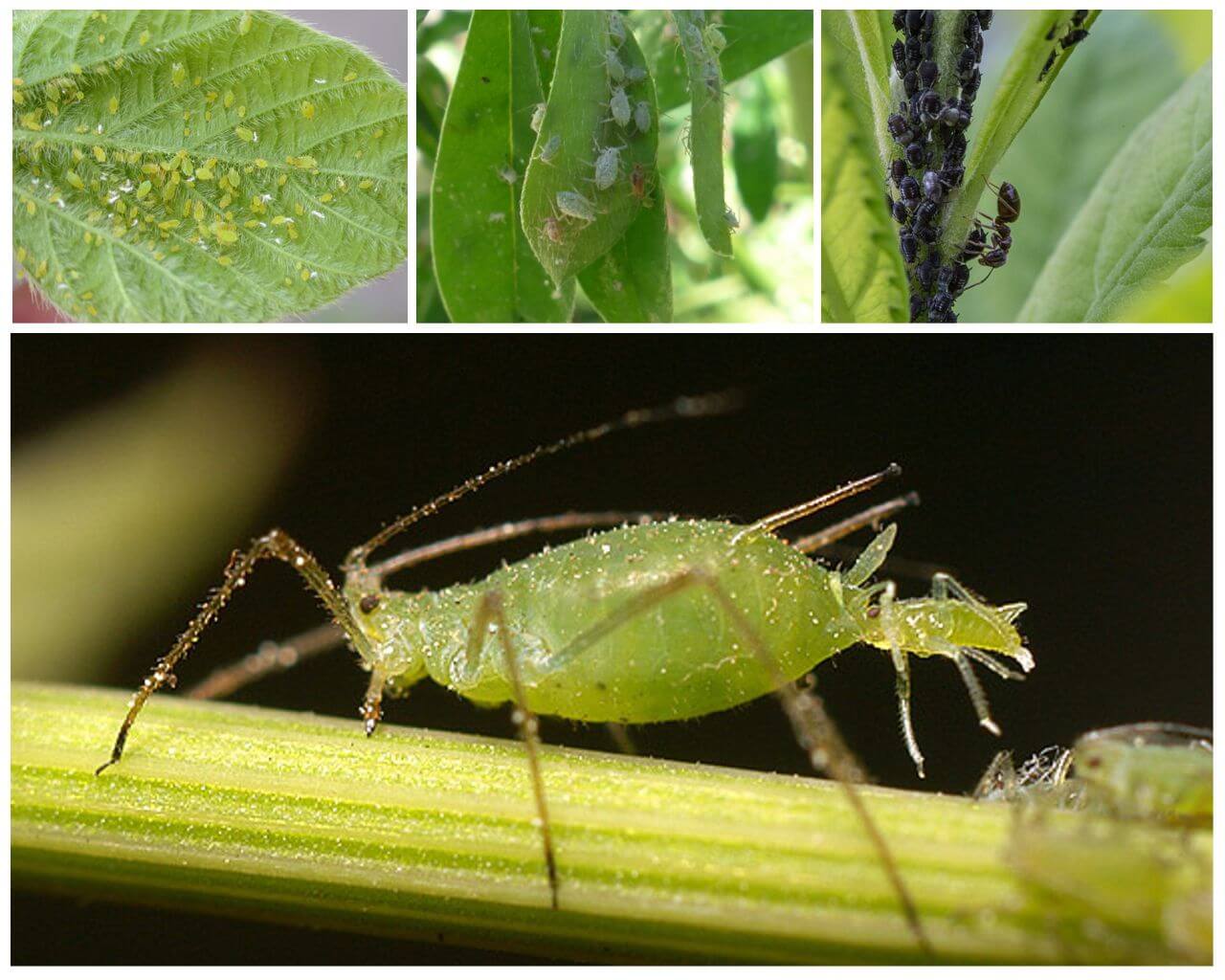
The abdomen is divided into 9 segmented parts. The first seven are spiracles. On the subsequent segments are the nipple tubes that perform excretory and secretory functions. The last segment is underdeveloped and has the appearance of a hairy tail.
Nutrition
Pests live in large colonies. Settling on a plant, they affect, first of all, leaves and young shoots. Aphids also eat flower buds, roots and stems of plants. As a result, the stands weaken and gradually wither away. Insects do not disdain any vegetation. Only certain species of aphids give preference to certain types of trees, shrubs or grasses.
Quite often they coexist with black ants. The fact is that the pad (the sweetish viscous liquid that aphids emit during life) is what the ant eats and loves. For this reason, garden goosebumps protect small pests from natural enemies: creepers and ladybugs.
Breeding

With the arrival of warm days, a wingless female is born from the aphid eggs laid in the bark of a tree in the fall, which becomes the founder of the colony. In the spring, under favorable conditions, the female aphid breeding parthenogenetically gives birth to similar virgin individuals.
On a note!
Parthenogenesis of aphids is a form of sexual reproduction, during which the eggs of adult females develop without mating with males.
It is also surprising how much such an individual lives - for its relatively short life, and a female virgin lives for no more than a month, she manages to reproduce several thousand similar creatures.
Aphid larvae are similar to adults. They grow rapidly, undergoing several links. After two weeks, the young individual becomes sexually mature. Thus, the number of colonies increases several times. When it reaches a critical size, females with wings appear in the light. By flying to other plants, they give life to new colonies. And only with the onset of autumn the population is replenished with full-fledged females and males. After mating, females lay eggs that hibernate and give rise to a new cycle.
What are the types of aphids
Insects are representatives of the winged wing squad, in which there are about 4 thousand species (about a thousand live on the European continent). All species of aphids prefer warm and humid climatic conditions, which allow them to increase their population by several times. Under adverse conditions, pest colonies can simply die. Below are the most common types of pests.
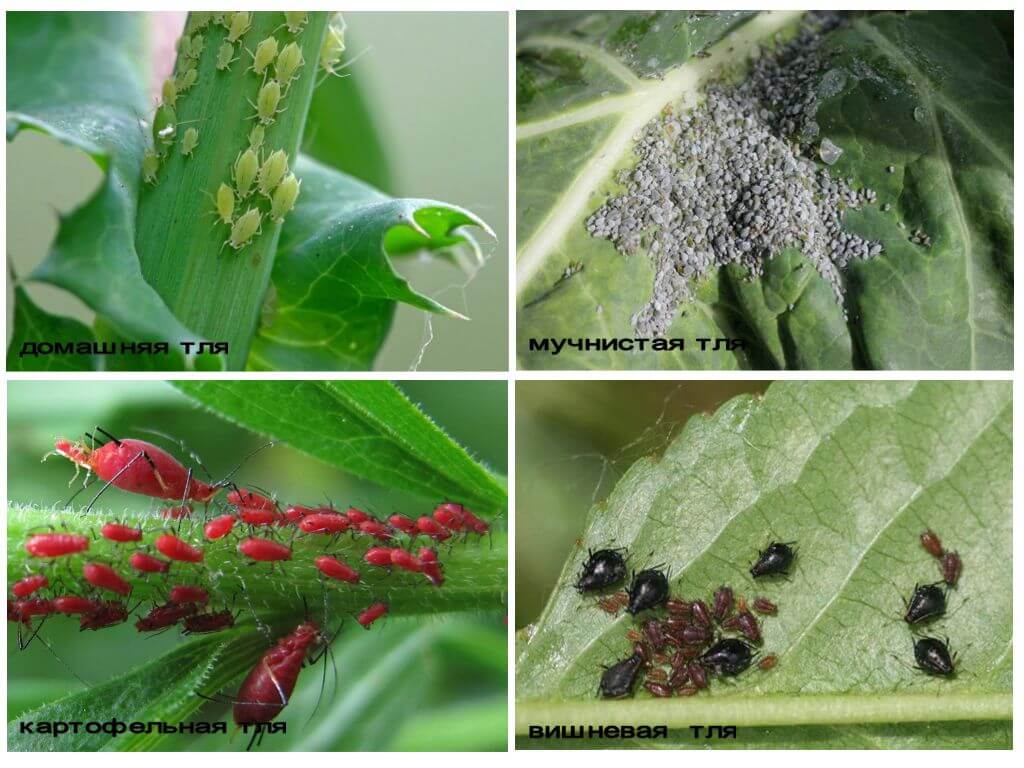
Domestic aphid
Indoor aphids, or as it is also called "home", includes several subspecies that differ in body color. There is red aphid, as well as individuals of white, black or green color. Particularly well, this pest is familiar to lovers of home flowers. They know how to get rid of pests that have settled on indoor plants.
Mealy aphids
Mealy aphid is a cream-colored insect that has an oval body shape with bristles on its sides. The surface of the body is covered with a snowy white coating. Powdery aphids affect indoor and greenhouse plants, as well as citrus and grape. The presence of insects gives a whitish hue, which covers the leaves of the plant. This contributes to the deformation of the stem, drying and falling of leaves and buds.
Potato aphid
Flightless individuals whose oval body is colored red or green. The insect up to 4 mm in length has a long antennae and tail. This species is notable for being adapted to low temperatures. Vegetable crops serve as a feed for such insects: potatoes, tomatoesbeets or cabbage. In the winter season, potato aphids prefer to settle on indoor and greenhouse plants.
On a note!
You can detect the pest by the spots left by it, the dried mesh or mold in places of a large accumulation of paddy.
Cherry aphid
This species of aphid differs from its counterparts in a brilliant black color. Pests mainly live on cherry or cherryand the latter plant is more vulnerable. Eggs winter in the buds and on the branches of trees, with the advent of spring, females - the founders of the colony - appear from them.
Black aphid is especially active on young shoots and foliage in the spring season. With the advent of summer, the surface of the plants coarsens, which leads to the death of most of the colony. However, up to this point, insects have time to do tremendous damage to fruit plants: slowing down growth, the formation of fewer fruit buds, small and non-mating fruits. Trees infected with cherry aphids are susceptible to disease and tolerate frosts worse.
Cereal aphid
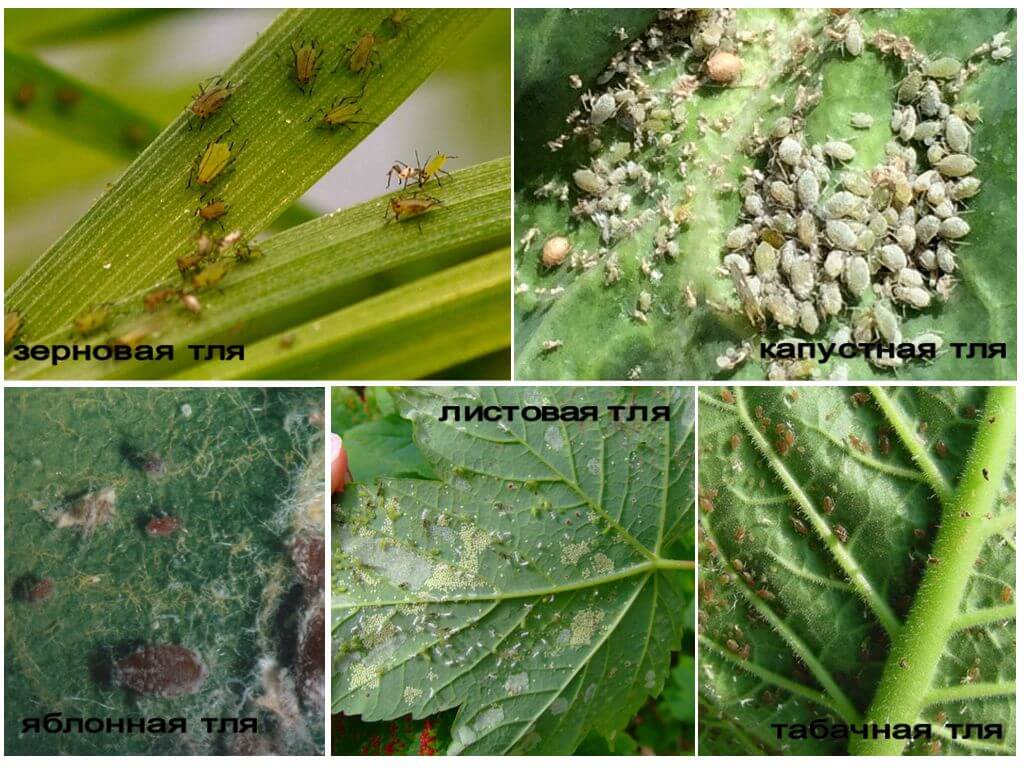
This variety is an inhabitant of the steppe and forest-steppe zones; individuals also settle in the fields sown with wheat, rye, barley or millet.The presence of insects at a time when the spike has not yet been formed, leads to the fact that the plants remain almost unkempt. If pollination has already happened, the grains are formed lightly and most often empty.
Cabbage aphid
It is a wingless insect, the dimensions of which do not exceed 2.5 mm. The body, covered with a grayish waxy coating, has an ovoid shape and a yellow-green color.
Aphids lay their eggs for wintering in cabbage leftovers left on the site. By mid-spring, larvae appear from them, which, like adults, feed on plant sap. What inhibits the growth and development of cabbage heads.
Apple aphid
For apple trees 3 types of insects pose a threat:
- Red (blood) is the most dangerous aphid species, whose representatives infect the root system of trees.
- Gray aphid lives mainly on apple trees and hawthorn during leaf formation. From which only the foliage that has appeared is curled, and the damage is covered with a characteristic dark red color. This leads to shedding of the ovaries and stunted growth of damaged young shoots, as a result of which they do not survive in frosts.
- Green aphid - is not only a danger to apple trees, it also affects pears, irgi and mountain ash. Damaged aphids begin to blacken, and a sooty fungus appears on the branches.
Leaf aphid
Leaf or grass aphids are active exclusively in the summer, preferring young plants. She sucks the juice from them, as a result of which the leaves and branches are deformed, which can even lead to the death of the seedling. It also settles on lawn and indoor flowers.
On a note!
The female winged aphid is painted yellow with a lemon tint, wingless individuals of brown color. It is this species of aphids that ants graze.
Tobacco aphid
Tobacco (peach or greenhouse) aphids live on tobacco, peach, plumalmonds apricot and other plants. It settles on them at the very beginning of spring.
Peach aphid has a yellow-green color, which masks it well on damaged plants. As a result of the presence of insects, the leaves turn yellow and become lifeless. Honey dew, which the pest emits in the process of life, leads to the appearance of soot fungus, and subsequently to the shedding of foliage. If you do not take timely measures to combat aphids, you can lose a large part of the crop.
There are good ones to fight these insidious insects. store tools. If you do not want to use chemicals, you can use folk remedieswell-proven in business.

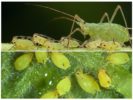

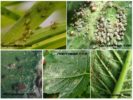

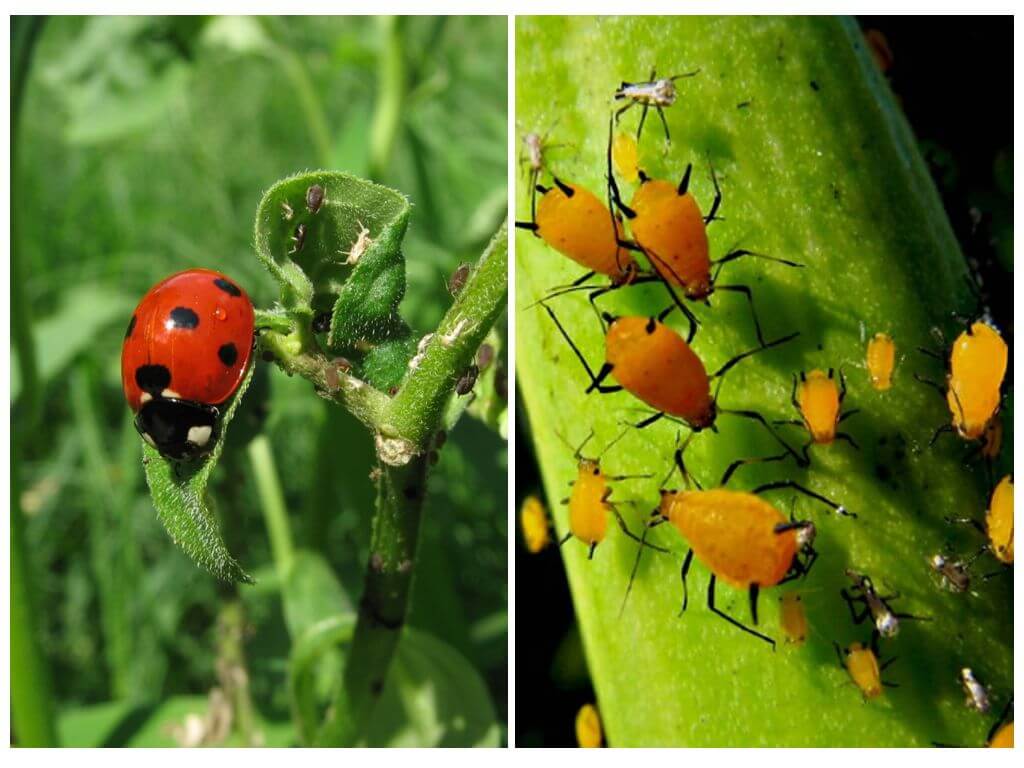

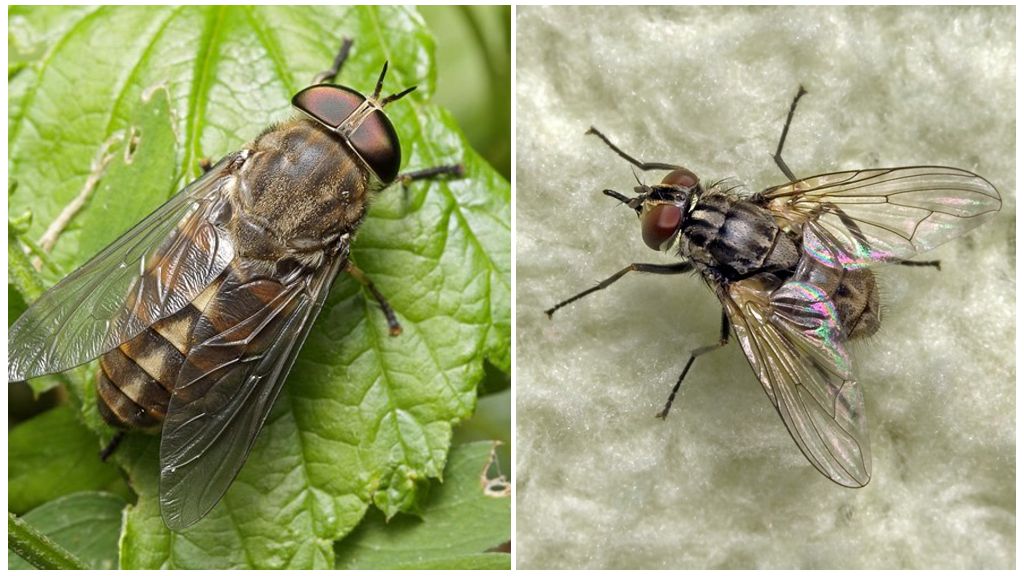
From cabbage seedlings, the aphids left only bits. Is it possible to save the situation?
Sprinkle seedlings with soapy water or sprinkle with ashes. Both methods are good and do not require the use of chemicals.
We are fighting aphids that season. For myself, revealed an effective remedy - fire water. To prepare it, you need to pour garlic and red pepper with water, after a week strain and spray the infected plants.
White aphid appeared on hibiscus. How to process a flower or is it better to get rid of it?
Why throw it away right away, brew celandine (100 g per 1 liter of water) and treat it with a plant.
Last year, the apple tree suffered a lot from aphids. Applied to Actaru.
Not so long ago saved Kalanchoe from aphids by a stream of water. Burdensome, but no bugs.
I use Inta-Vir from aphids both in the garden and in the flower garden.
I relieve indoor plants from aphids by infusion of chili peppers (8 pcs.), Soap shavings (1 tbsp. L.) And 1 l of water. The solution needs to be insisted for a day, and then spray them with plants.